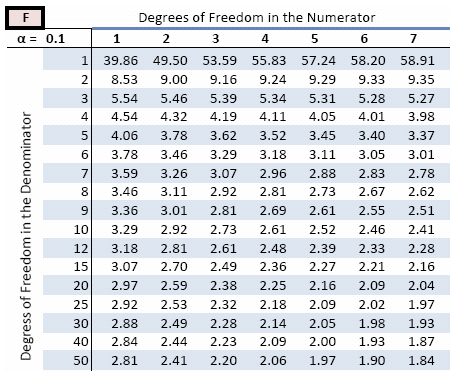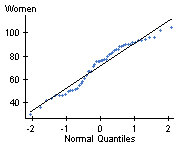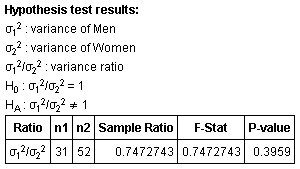Section 11.3: Inference about Two Standard Deviations
Objectives
By the end of this lesson, you will be able to...
- find critical values of the F-distribution
- test hypotheses regarding two population standard deviations
For a quick overview of this section, watch this short video summary:
The last parameters we need to compare between two populations are the variance and standard deviation. Before we can develop a hypothesis test comparing two population parameters, we need another distribution.
Fisher's F-distribution
Unlike the mean, the standard deviation is extremely susceptible to extreme values, and consequently does a very poor job of measuring spread for distributions that are not symmetric. So before we do any inference regarding population standard deviations, we must first verify that the samples come from normally distributed populations.
Fisher's F-distribution
If ![]() and
and ![]() and
and ![]() are sample variances from independent simple random samples of size n1and n2, respectively, drawn from normal populations, then
are sample variances from independent simple random samples of size n1and n2, respectively, drawn from normal populations, then
![]()
follows the F-distribution with n1-1 degrees of freedom in the numerator and
n2-1 degrees of freedom in the denominator.
Properties of the F-distribution
- Like the Χ2 distribution, it is not symmetric. It is skewed right
- The shape depends on the degrees of freedom in the numerator and denominator.
- F≥0
Notice here that the samples must come from normally distributed populations.
Finding Critical Values
Find critical values in the F-distribution using a table is done in a similar manner to the t and Χ2 tables, though with some differences. The values in the table still represent values with the indicidated α area to the right, but because the F distribution has two degreees of freedom rather than one, it requires a separate table for each α.
Before we start the section, you need a copy of the table. You can download a printable copy of this table, or use a copy from a textbook. That table will look different than the printable version linked above because the publisher did not provide a digital version.

So the values in the table above are the critical values:
![]()
You may wonder how we find critical values for left-tailed tests. To do that, we use the same table and the following formula:
![]()
Let's try a couple examples.
Example 1
Find the value of the F-distribution that has α=0.05 area to the right, with 10 degrees of freedom in the numerator, and 15 degrees of freedom in the denominator.

So F0.05, 10, 15 = 2.54
Example 2
Find the value of the F-distribution that has α=0.05 area to the left, with 20 degrees of freedom in the numerator, and 8 degrees of freedom in the denominator.
| F0.95, 20, 8 = | 1 | 1 | ≈ 0.41 | |
| F0.05, 8, 20 | 2.45 |
Finding Critical Values Using StatCrunch
Click on Stat > Calculators > F Enter the numerator and denominator degrees of freedom, the direction of the inequality, and the probability (leave X blank). Then press Compute. |
Example 3
Use the technology of your choice to find the value from the F-distribution with α=0.01 area to the right if samples of size 15 and 20 are taken.
Using StatCrunch:

So F0.01, 14, 19 = 3.19
Performing a Hypothesis Test Regarding Two Population Standard Deviations
Step 1: State the null and alternative hypotheses.
| Two-Tailed H0: H1: |
Left-Tailed H0: H1: |
Right-Tailed H0: H1: |
Step 2: Decide on a level of significance, α.
Step 3: Compute the test statistic, ![]() .
.
Step 4: Determine the P-value.
Step 5: Reject the null hypothesis if the P-value is less than the level of significance, α.
Step 6: State the conclusion.
Hypothesis Testing Regarding Two Population Standard Deviations Using StatCrunch
The results should appear. |
Example 4
Problem:In Example 1 in Section 11.2, we compared the average scores of men and women on a Mth096 exam. In that test, we assumed that the standard deviations of the two groups were equal. Test the assumption at the α=0.1 level of significance.
Solution:
First, we need to check the conditions. We know from Example 1 that neither sample contains outliers, but we do not know if they come from normally distributed populations. We'll use StatCrunch to perform Q-Q plots.


While the two plots aren't exactly linear, it does appear that the samples could come from normally distributed populations, so our conditions are satisfied.
Step 1:
H0: ![]()
H1: ![]()
Step 2: α = 0.1 (given)
Step 3: (we'll use StatCrunch)
Step 4: Using StatCrunch:

Step 5: Since the P-value > α, we do not reject the null hypothesis.
Step 6: Based on these results, there is no evidence to support the claim that the standard deviations are not equal.
